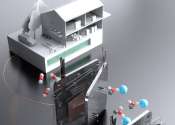Japan's 'flying car' gets off ground, with a person aboard (Video)
The decades-old dream of zipping around in the sky as simply as driving on highways may be becoming less illusory.
Aug 28, 2020
23
78013
Hi Tech & Innovation

The decades-old dream of zipping around in the sky as simply as driving on highways may be becoming less illusory.
Aug 28, 2020
23
78013
Energy & Green Tech

UC Berkeley researchers just broke another record in photovoltaic efficiency, an achievement that could lead to an ultralight engine that can power drones for days.
Jul 26, 2019
7
5973
Energy & Green Tech

The renewable energy sector is facing a quandary: how Australia will dispose of 80 million solar panels in an environmentally friendly way when they reach the end of their life.
Mar 21, 2023
5
535
Hi Tech & Innovation

Artificial intelligence not only affords impressive performance, but also creates significant demand for energy. The more demanding the tasks for which it is trained, the more energy it consumes.
Sep 8, 2023
0
968
Engineering

The search is on worldwide to find ways to extract carbon dioxide from the air or from power plant exhaust and then make it into something useful. One of the more promising ideas is to make it into a stable fuel that can ...
Oct 30, 2023
1
240
Energy & Green Tech

Scientist have developed a lithium ion battery that charges at an elevated temperature to increase reaction rate but keeps the cell cool during discharge, showing the potential to add 200 miles of driving range to an electric ...
Oct 30, 2019
13
9755
Energy & Green Tech

University of Delaware (UD) engineers have demonstrated a way to effectively capture 99% of carbon dioxide from air using a novel electrochemical system powered by hydrogen.
Feb 3, 2022
4
3185
Energy & Green Tech

Hydrogen can be produced by electrolysis of water, ideally with solar cells or wind power providing the electrical energy required. This "green" hydrogen is expected to play an important role in the energy system of the future. ...
Mar 20, 2023
0
1234
Hardware

Physicists at Lancaster University have demonstrated that their invention of a new type of memory device could transform the way computers, smartphones and other gadgets work.
Jan 20, 2020
1
1485
Engineering

In a step closer to skyscrapers that serve as power sources, a team led by University of Michigan researchers has set a new efficiency record for color-neutral, transparent solar cells.
Aug 17, 2020
2
3272
The cell is the structural and functional unit of all known living organisms. It is the smallest unit of an organism that is classified as living, and is often called the building block of life. Some organisms, such as most bacteria, are unicellular (consist of a single cell). Other organisms, such as humans, are multicellular. (Humans have an estimated 100 trillion or 1014 cells; a typical cell size is 10 µm; a typical cell mass is 1 nanogram.) The largest known cell is an unfertilized ostrich egg cell.
In 1835 before the final cell theory was developed, a Czech Jan Evangelista Purkyně observed small "granules" while looking at the plant tissue through a microscope. The cell theory, first developed in 1839 by Matthias Jakob Schleiden and Theodor Schwann, states that all organisms are composed of one or more cells. All cells come from preexisting cells. Vital functions of an organism occur within cells, and all cells contain the hereditary information necessary for regulating cell functions and for transmitting information to the next generation of cells.
The word cell comes from the Latin cellula, meaning, a small room. The descriptive name for the smallest living biological structure was chosen by Robert Hooke in a book he published in 1665 when he compared the cork cells he saw through his microscope to the small rooms monks lived in.
This text uses material from Wikipedia, licensed under CC BY-SA